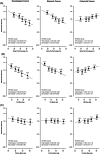Adiposity and risks of gastrointestinal cancers: A 10-year prospective study of 0.5 million Chinese adults
- PMID: 39737804
- PMCID: PMC11970548
- DOI: 10.1002/ijc.35303
Adiposity and risks of gastrointestinal cancers: A 10-year prospective study of 0.5 million Chinese adults
Abstract
Associations of adiposity with risks of oesophageal squamous cell carcinoma (ESCC) and non-cardia stomach cancer, both prevalent in China, are still inconclusive. While adiposity is an established risk factor for colorectal cancer, the relevance of fat-free mass and early-adulthood adiposity remains to be explored. The prospective China Kadoorie Biobank study included 0.5 million adults (aged 30-79 years) from 10 areas in China. Participants' body size and composition were measured at baseline and at resurveys (amongst a subset). After >10 years of follow-up, 2350, 3345 and 3059 incident cases of oesophageal (EC), stomach (SC) and colorectal (CRC) cancers were recorded, respectively. Cox regression was used to estimate hazard ratios (HRs) for these cancers in relation to different adiposity traits. General and central adiposity were inversely associated with EC (primarily ESCC) risk, with HRs of 0.81 (95% CI 0.77-0.85), 0.76 (0.72-0.81) and 0.87 (0.83-0.92) per SD increase in usual levels of BMI, body fat percentage (BF%) and waist circumference (WC), respectively. Adiposity was also inversely associated with SC risk [HR = 0.79 (0.75-0.83) and 0.88 (0.84-0.92) per SD increase in usual BF% and WC], with heterogeneity by cardia and non-cardia subsites, and positively associated with CRC [HR = 1.09 (1.03-1.15) and 1.17 (1.12-1.22) per SD higher usual BF% and WC]. Fat-free mass was inversely associated with EC [HR = 0.93 (0.89-0.98) per SD increase] but positively associated with CRC [1.09 (1.04-1.14)], while BMI at age 25 was positively associated with all three cancers. After mutual adjustment, general adiposity remained inversely associated with EC and SC, while central adiposity remained positively associated with CRC.
Keywords: adiposity; body fat; gastrointestinal cancers.
© 2024 The Author(s). International Journal of Cancer published by John Wiley & Sons Ltd on behalf of UICC.
Conflict of interest statement
The authors declare no conflicts of interest.
Figures




Similar articles
-
Anthropometry, body fat composition and reproductive factors and risk of oesophageal and gastric cancer by subtype and subsite in the UK Biobank cohort.PLoS One. 2020 Oct 20;15(10):e0240413. doi: 10.1371/journal.pone.0240413. eCollection 2020. PLoS One. 2020. PMID: 33079929 Free PMC article.
-
Associations of General and Central Adiposity With Incident Diabetes in Chinese Men and Women.Diabetes Care. 2018 Mar;41(3):494-502. doi: 10.2337/dc17-1852. Epub 2018 Jan 3. Diabetes Care. 2018. PMID: 29298802 Free PMC article.
-
Adiposity and risks of colorectal and small intestine cancer in Chinese adults: a prospective study of 0.5 million people.Br J Cancer. 2018 Jul;119(2):248-250. doi: 10.1038/s41416-018-0124-8. Epub 2018 Jun 6. Br J Cancer. 2018. PMID: 29872150 Free PMC article.
-
Cancer incidence in relation to body fatness among 0.5 million men and women: Findings from the China Kadoorie Biobank.Int J Cancer. 2020 Feb 15;146(4):987-998. doi: 10.1002/ijc.32394. Epub 2019 May 24. Int J Cancer. 2020. PMID: 31115907 Free PMC article.
-
Young adulthood and adulthood adiposity in relation to incidence of pancreatic cancer: a prospective study of 0.5 million Chinese adults and a meta-analysis.J Epidemiol Community Health. 2017 Nov;71(11):1059-1067. doi: 10.1136/jech-2017-208895. Epub 2017 Sep 12. J Epidemiol Community Health. 2017. PMID: 28900029 Free PMC article.
References
-
- Sung H, Ferlay J, Siegel RL, et al. Global Cancer Statistics 2020: GLOBOCAN estimates of incidence and mortality worldwide for 36 cancers in 185 countries. CA Cancer J Clin. 2021;71(3):209‐249. - PubMed
-
- International Agency for Research on Cancer . Global Cancer Observatory. Available from: https://gco.iarc.who.int/en.
-
- Lagergren J, Smyth E, Cunningham D, Lagergren P. Oesophageal cancer. Lancet. 2017;390(10110):2383‐2396. - PubMed
MeSH terms
Grants and funding
- MC_UU_00017/1/MRC_/Medical Research Council/United Kingdom
- C16077/A29186/CRUK_/Cancer Research UK/United Kingdom
- MC_UU_12026/2/MRC_/Medical Research Council/United Kingdom
- 82192900/National Natural Science Foundation of China
- 104085/Z/14/Z/WT_/Wellcome Trust/United Kingdom
- 2016YFC0900500/National Key Research and Development Program of China
- 82192901/National Natural Science Foundation of China
- CH/1996001/9454/BHF_/British Heart Foundation/United Kingdom
- C500/A16896/CRUK_/Cancer Research UK/United Kingdom
- 212946/Z/18/Z/WT_/Wellcome Trust/United Kingdom
- MC_U137686851/MRC_/Medical Research Council/United Kingdom
- 82192904/National Natural Science Foundation of China
- WT_/Wellcome Trust/United Kingdom
- 202922/Z/16/Z/WT_/Wellcome Trust/United Kingdom
- 08815/WT_/Wellcome Trust/United Kingdom
- 8223000863/National Natural Science Foundation of China
- 29186/CRUK_/Cancer Research UK/United Kingdom
LinkOut - more resources
Full Text Sources
Medical
Miscellaneous

